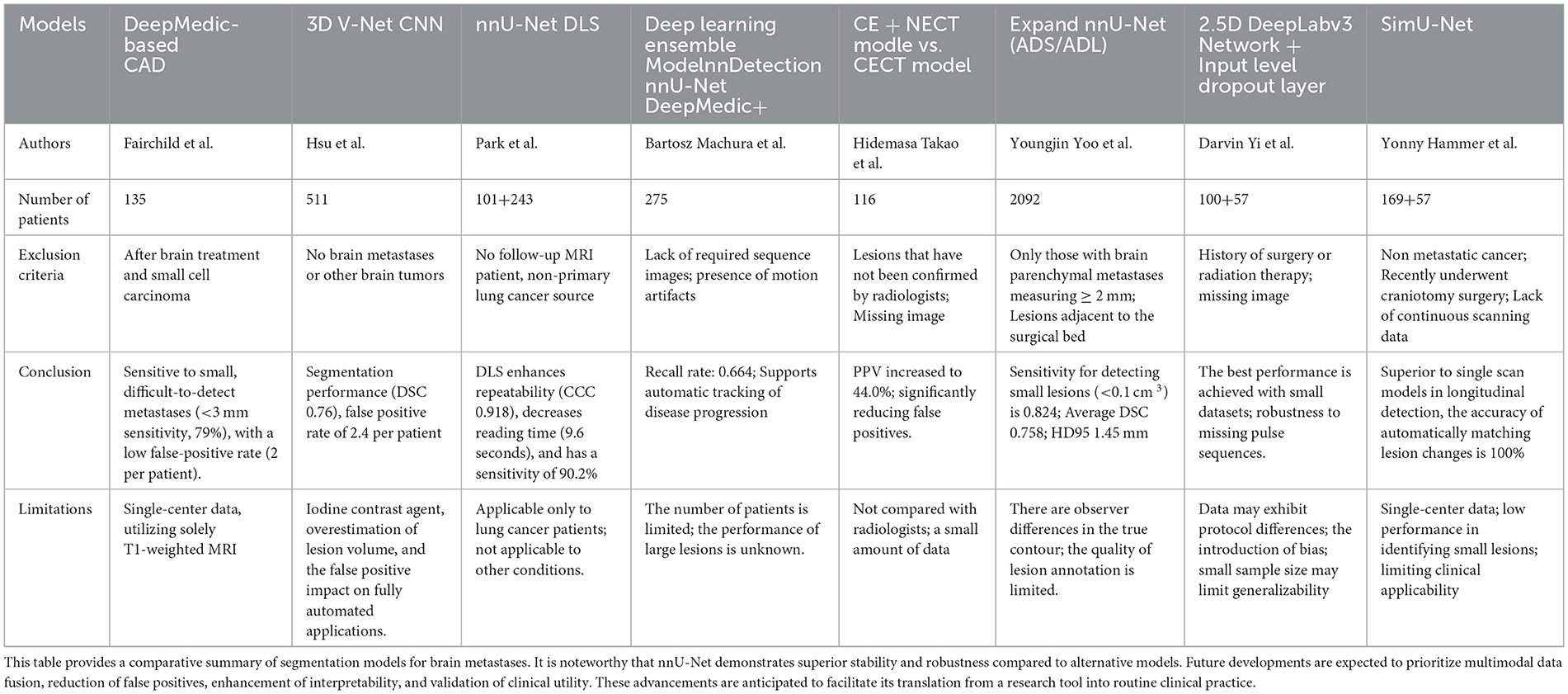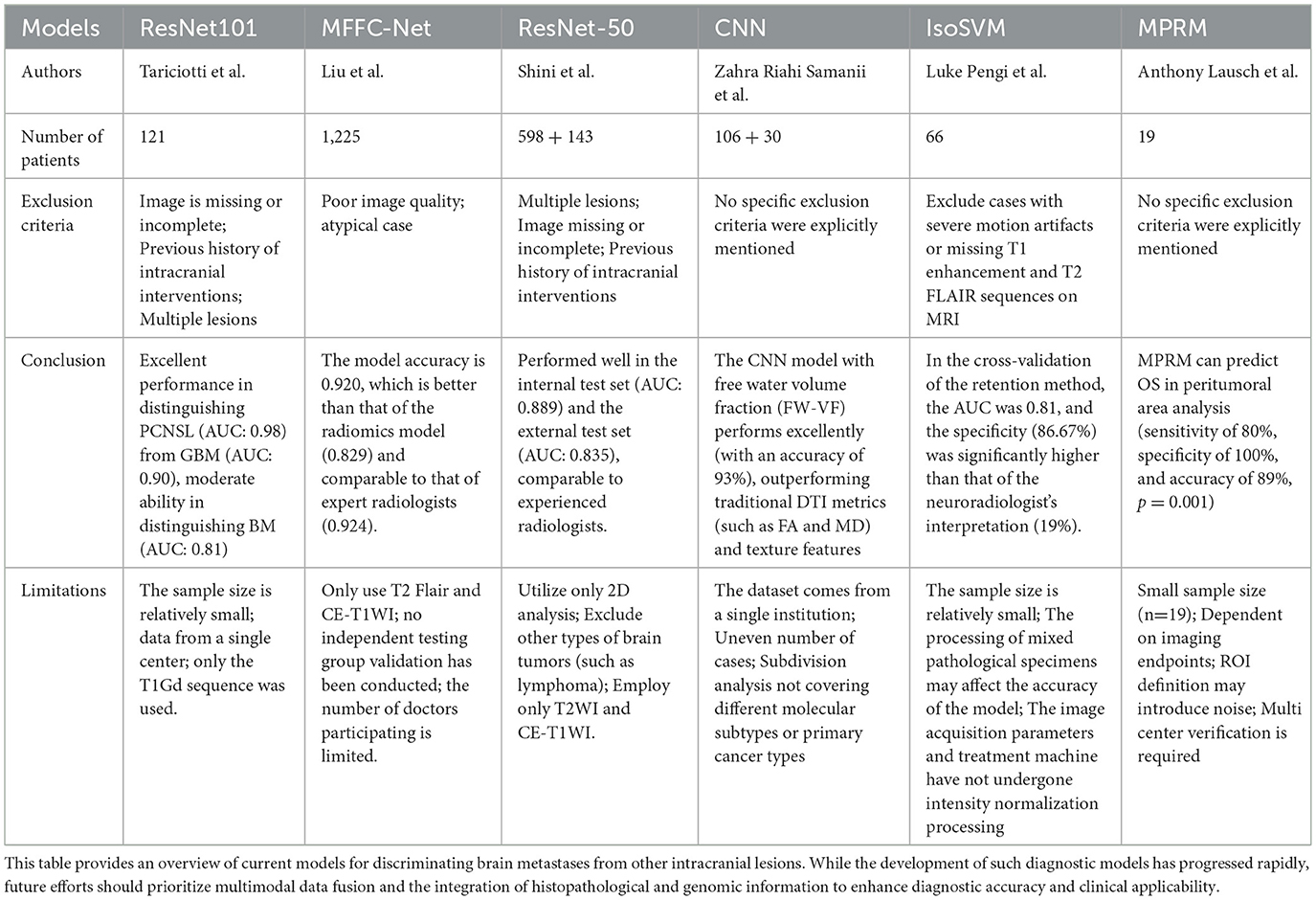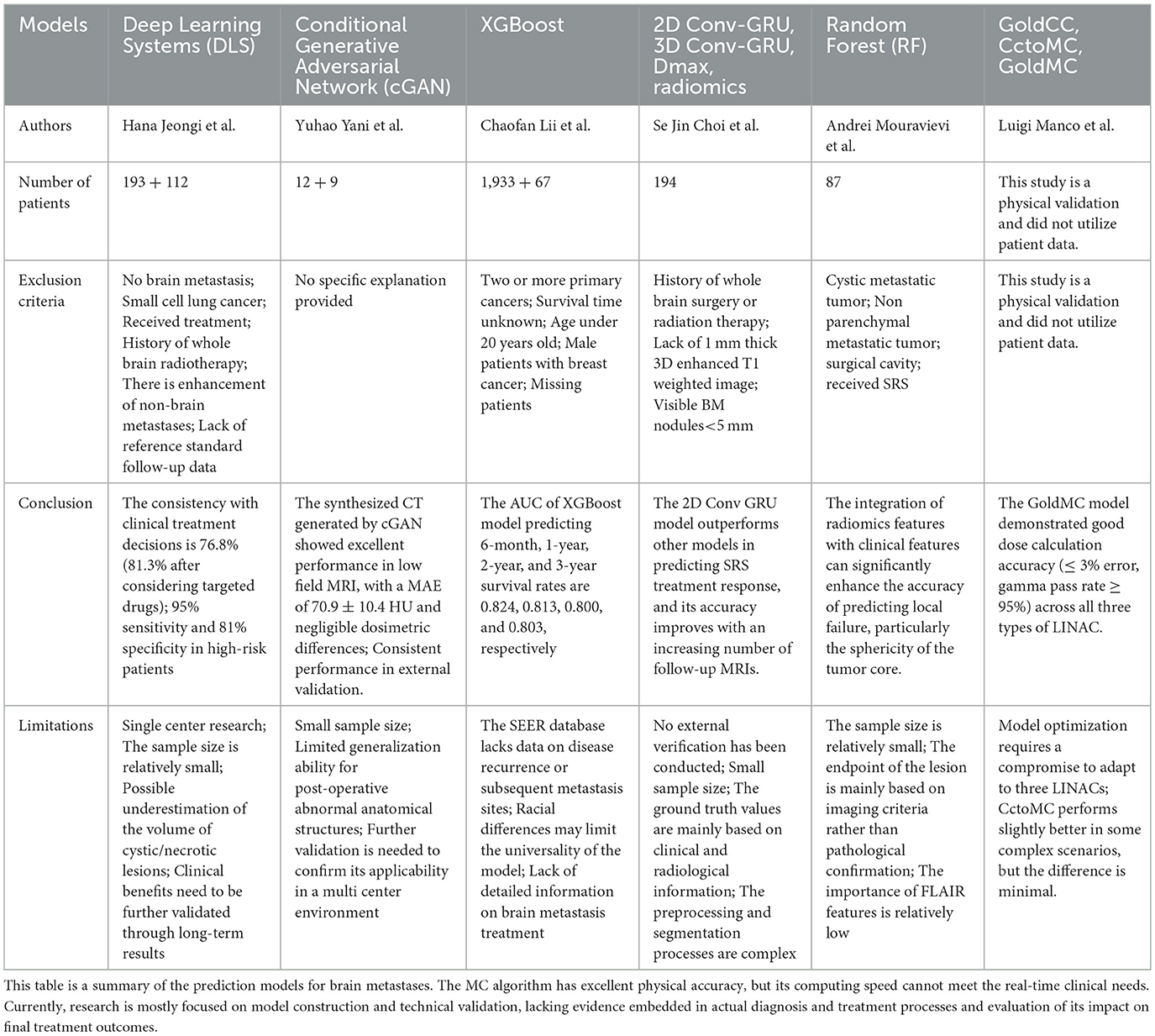- 1Medical Imaging, Faculty of Radiology, Shandong First Medical University, Tai'an, Shandong, China
- 2Clinical Medicine, Faculty of Clinical and Basic Medicine, Shandong First Medical University, Jinan, Shandong, China
- 3Department of Nuclear Medicine, Shandong Provincial Hospital Affiliated to Shandong First Medical University, Jinan, Shandong, China
- 4Department of Radiology, Shandong University of Traditional Chinese Medicine Affiliated Hospital, Jinan, China
As artificial intelligence (AI) continues to evolve, its integration into medical practice is becoming increasingly prominent, particularly in the field of neuro-oncology. This review examines the application of AI—specifically machine learning (ML) and deep learning (DL)—in the imaging evaluation of brain metastases (BM). A systematic search of PubMed was conducted to identify relevant studies published within the past 5 years. The retrieved literature was categorized and analyzed according to three key clinical tasks: segmentation, differential diagnosis, and prognostic prediction. We first outline the capabilities of AI in the automatic detection and segmentation of BM using advanced imaging techniques. Subsequently, we synthesize evidence on how AI aids in distinguishing BM from other intracranial structures and lesions. Finally, we discuss the emerging role of AI in predicting disease prognosis and the development of new metastatic abnormalities. Current evidence suggests that AI not only enhances diagnostic efficiency and reproducibility but also provides clinically meaningful insights that support personalized treatment planning. Importantly, the integration of AI into neuro-oncological imaging remains at a nascent stage, indicating substantial potential for future growth and refinement in both technical performance and clinical applicability.
1 Introduction
BM represent secondary malignant lesions that disseminate to the brain from primary extracranial tumors via hematogenous or lymphatic pathways. With continued improvements in cancer patient survival, the incidence of BM has risen significantly, currently affecting between 10% and 40% of all cancer patients (1). The most frequent primary malignancies leading to BM include lung cancer, breast cancer, melanoma, renal cell carcinoma, and colorectal cancer. Notably, non-small cell lung cancer (NSCLC) alone accounts for BM in approximately 28.6% of cases (2).
Artificial intelligence (AI), a rapidly advancing discipline within computer science, aims to emulate human cognitive functions to address complex problems. A core goal of AI is to develop systems capable of autonomous reasoning and decision-making, with performance levels that can meet or exceed human expertise in specific domains. In healthcare, AI algorithms are increasingly being deployed to improve diagnostic precision, prognosticate clinical outcomes, accelerate drug development, and enhance the efficiency of large-scale data analysis in biomedical research.
Through a comprehensive review and synthesis of current literature, we have identified and summarized key advancements in AI applications for BM management. An overview of this process is illustrated in Figure 1.
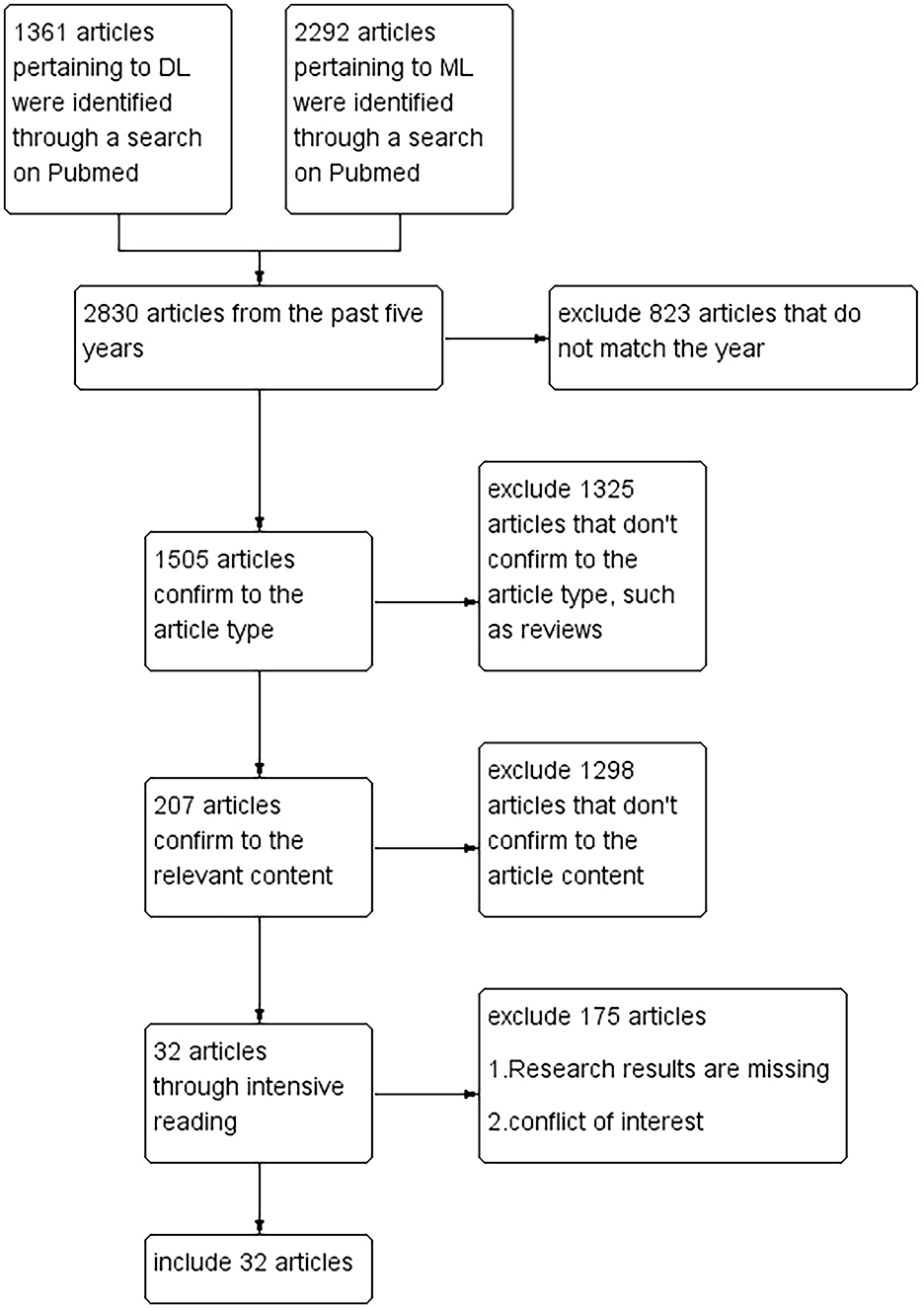
Figure 1. Specific steps for filtering articles. A total of 3,653 articles on AI were collected. Eight hundred and twenty-three articles were excluded based on age, but 1 prospective article was retained. One thousand three hundred and twenty-five articles were excluded based on article type, and 1,298 articles were excluded based on content relevance. Finally, 32 articles were retained through intensive reading.
2 Application of AI in BM detection and segmentation
The integration of AI into the detection and segmentation of BM reflects a critical alignment between unmet clinical demands and technological feasibility. Current evidence indicates that AI holds considerable promise for improving diagnostic accuracy, reducing missed diagnoses, and supporting more precise treatment planning. Research efforts are primarily concentrated on high-resolution MRI, while exploration of emerging imaging techniques—as well as the fusion of multimodal imaging data—represents a major direction for future innovation. Key developments in this domain are summarized in Table 1.
2.1 Detection and segmentation in single sequence MRI
BM represent a frequent and serious complication of systemic cancer, profoundly affecting patient survival and quality of life. Early and accurate detection of BM is essential for formulating effective radiation therapy strategies. However, manual detection and segmentation remain substantially challenging due to the characteristically small size, high multiplicity, and ill-defined borders of metastatic lesions.
DL-based approaches offer promising solutions to these limitations. The integration of architectures such as the Single Shot MultiBox Detector (SSD) has been shown to markedly enhance detection performance in DL systems (3).
The U-Net architecture, a widely adopted convolutional neural network (CNN) for biomedical image segmentation (illustrated in Figure 2), excels at combining high-resolution contextual details with semantically rich features, leading to significant gains in segmentation accuracy. Further refinements through novel algorithmic integrations can augment the model's precision (4). The incorporation of longitudinal timeline analysis, in addition to cross-sectional evaluation, has also been demonstrated to improve BM detection rates (5).
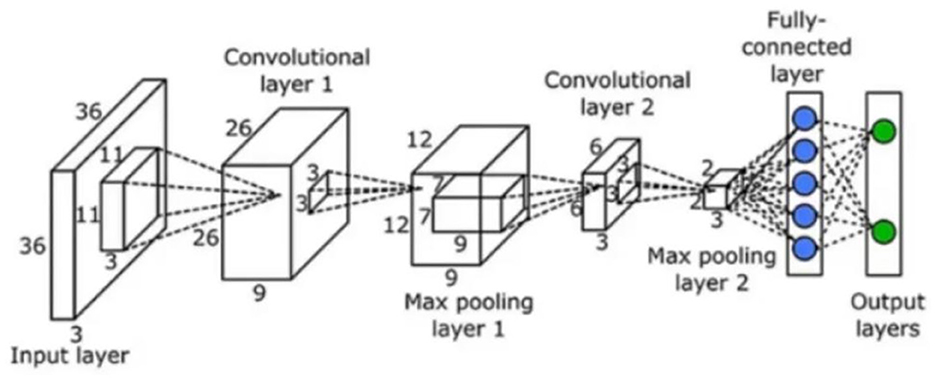
Figure 2. Schematic diagram of the CNN model architecture. The process begins with inputting the target image. The second step involves extracting features from the target using convolutional kernels. Once extracted, these features undergo pixel-level processing. The third step further compresses the features through max pooling, which helps retain the most salient characteristics and organizing the pooled features into a 3 × 3 grid. In step four, the feature map is flattened, converting the 3 × 3 patches into a one-dimensional array. Step five consists of feeding this flattened data into a fully-connected layer. Finally, the output result is generated.
Moreover, the nnU-Net (Extended U-Net Model)—an adaptive framework designed for medical image segmentation—can be optimized through the incorporation of two specialized modules: Adaptive Data Sampling (ADS) and Adaptive Dice Loss (ADL). These enhancements have proven effective in substantially elevating detection performance (6).
2.2 Combining multi-sequence MRI for brain metastasis detection and segmentation
BM exhibit distinct and often complementary imaging features across different MRI sequences, a characteristic that has prompted most current DL models—including those discussed earlier—to rely predominantly on single-sequence data during training. However, emerging evidence indicates that the integration of multi-sequence MRI, particularly when combined with subtraction imaging techniques, can substantially enhance model performance in BM detection (7).
Although multi-sequence strategies improve diagnostic sensitivity, their clinical applicability is often limited by incomplete imaging protocols in real-world settings (8). To address this issue, the research group led by Darvin Yi introduced a Dropout-based training regimen that randomly masks pulse sequences during model training. This method not only enhances robustness to missing sequences but also preserves high detection accuracy when all sequences are available (9).
For achieving optimal detection performance, deep learning ensemble models have shown considerable promise in effectively integrating multimodal MRI data, demonstrating superior capability in the accurate identification of BM across diverse clinical scenarios (10).
2.3 Research on emerging MRI image sequences
The integration of artificial intelligence with novel MRI sequences for model training and validation—building upon established technological foundations—has attracted significant attention within the neuro-oncology and radiology research communities. A notable example is black blood (BB) imaging, an advanced sequence that enhances lesion conspicuity by suppressing intravascular signal, thereby improving contrast between metastases and adjacent vascular structures (11). When coupled with widely adopted architectures such as the 3D U-Net, BB imaging has been shown to deliver superior detection performance and robust generalizability across diverse clinical datasets (12).
2.4 Research on small brain metastases
The detection of small BM presents notable imaging challenges attributable to their limited spatial extent and subtle presentation. Key among these are partial volume effects in high-resolution MRI, which can induce signal blurring and reduce overall image clarity. Additionally, smaller BM lesions often exhibit less pronounced contrast enhancement compared to their larger counterparts, complicating differentiation from adjacent vascular structures. Further reducing detectability, lesions situated near blood vessels or dural sinuses are frequently obscured by flow-related artifacts.
Current advances in computer-aided detection (CAD) systems, augmented with DL, demonstrate the potential to overcome these limitations. DL-enhanced CAD can delineate lesion boundaries with high precision, outperforming conventional clinical detection methods in accuracy and reproducibility (13).
2.5 Application in CT imaging
Owing to the prolonged acquisition times and limited accessibility of MRI, CT remains widely utilized for the screening of BM. Conventional CT evaluation depends on radiologists performing side-by-side visual assessment of contrast-enhanced (CE) and non-contrast (NECT) scans—a process that is not only labor-intensive but also prone to diagnostic oversights.
Recent advances demonstrate that leveraging both CE and NECT images as model inputs, while minimizing inter-sequence discrepancies, can significantly enhance detection performance while fulfilling the real-time requirements of clinical workflows (14). In a study by Dylan G. Hsu et al., a model trained on paired T1ce and CECT images achieved an overall detection sensitivity of 90%, with sensitivities of 63%−68% for metastases smaller than 3 mm. This represents a marked improvement over models trained on T1ce images alone (15).
3 AI differential diagnosis of BM
AI enables high-sensitivity analysis of MRI, CT, and other imaging modalities. It can accurately detect millimeter-scale lesions and extract subtle imaging features—such as ill-defined lesion margins, heterogeneity in enhancement patterns, and perilesional edema distribution—that are challenging to discern with the human eye. These capabilities significantly enhance the ability of radiologists to differentiate between primary gliomas, brain metastases, and other intracranial pathologies. A summary of the relevant research is provided in Table 2.
3.1 Distinguishing between BM and GBM
As a common malignant brain tumor, BM exhibits numerous imaging features overlapping with glioblastoma (GBM), posing considerable diagnostic challenges for physicians (16). While conventional radiological characteristics can aid in distinguishing BM from GBM, the use of contrast-enhanced imaging further improves lesion detectability (17). Studies have demonstrated that DL models applied to conventional MRI can support preoperative differentiation between GBM and solitary BM, achieving superior diagnostic accuracy compared to neuroradiologists (18). Moreover, integrating multiparametric MRI to capture spatial tumor heterogeneity has been shown to significantly enhance model performance, with reported sensitivity, specificity, and accuracy reaching 80%, 100%, and 89%, respectively—outperforming traditional single-parameter parametric response mapping (PRM) and tumor volume–based metrics (19). Notably, this approach holds promise for extension to other cancer types and biomarker discovery studies, offering a novel technological pathway for personalized treatment evaluation. Traditionally, tumor classification relies on histopathological biopsy and multiparametric MRI assessment. By exploiting differences in extracellular water content between vasogenic edema and infiltrating tumor tissue—combined with innovative DL techniques designed to characterize the peritumoral microenvironment of GBM and BM—distinctive tumor signatures can be identified to improve diagnostic precision (20).
3.2 Distinguish between BM and radiation necrosis
Distinguishing BM from radiation necrosis (RN)—a delayed complication of radiotherapy—remains a significant diagnostic challenge. RN results from necrosis, inflammatory responses, and vascular injury in irradiated brain tissue, typically manifesting months to years after treatment (21). For existing analytical models, the implementation of novel algorithms offers substantial improvements in performance, moving beyond the sole development of new network architectures to enhance differentiation accuracy and clinical utility (22).
3.3 Simultaneously distinguish BM from various other brain tumors
The imaging features of GBM subtypes often overlap with those of primary central nervous system lymphoma (PCNSL) and BM, posing considerable challenges in preoperative differential diagnosis. A ResNet101-based model developed by Leonardo Tariciotti et al. demonstrated that incorporating gadolinium-enhanced MRI significantly improves diagnostic accuracy in distinguishing these entities (23). Although these three tumor types share certain conventional MRI characteristics across multiple sequences, they also exhibit distinct radiomic profiles. The extraction and integration of multi-sequence radiomic features through AI can substantially enhance lesion classification and diagnostic precision (24).
4 AI-assisted treatment for BM
AI enables the prediction of progression-free survival (PFS) and overall survival (OS) in patients with brain metastases by integrating quantitative imaging features with clinical data. This integrated approach provides a robust foundation for developing personalized treatment strategies and improving prognostic assessment. A summary of the supporting research is presented in Table 3.
4.1 Optimization of treatment plan
Among brain tumors, brain metastases (BM) are recognized as one of the most aggressive entities. Their pronounced morphological heterogeneity, however, complicates clinical efforts to optimize treatment dosing and intensity. Early subtype differentiation of BM can facilitate more tailored therapeutic strategies, thereby improving disease control and helping preserve functional brain tissue (25). Rapid advances in AI-driven BM segmentation have enabled classification algorithms based on segmentation network architectures to enhance patient stratification and significantly reduce diagnostic and therapeutic timelines (26).
Owing to their distinct imaging principles, CT and MRI capture complementary characteristics of BM, offering a more comprehensive diagnostic basis and supporting more precise radiation planning with reduced marginal failures. Nevertheless, the extended acquisition times associated with combined CT and MRI protocols may delay treatment initiation, potentially compromising clinical outcomes. There is growing interest in reducing dependency on multi-modal imaging—beginning at the acquisition stage—to maintain radiotherapy accuracy without sacrificing detection efficacy (27).
4.2 Predicting treatment response and local failure
Stereotactic radiosurgery (SRS) offers significant benefits for patients with BM, including local tumor control, symptomatic relief, and potential improvement in overall survival. Nevertheless, challenges persist in optimizing drug selection, dosage individualization, and treatment parameter configuration, underscoring the need for AI-based prognostic tools. Integrating radiomic features from BM with ML enables assessment of local recurrence risk following SRS. Beyond conventional predictors, tumor core sphericity has emerged as an independent prognostic factor that may further enhance predictive accuracy (28).
The Monte Carlo (MC) technique represents the most accurate method for dose calculation and optimization in radiotherapy and serves as a key tool for validating treatment plan accuracy. However, its clinical adoption has been limited by computationally intensive processes. In a systematic clinical validation across multiple matched linear accelerators (LINACs), Luigi Manco et al. demonstrated that the optimized GoldMC model achieved agreement within 3% between calculated and measured point doses, underscoring the physical precision of MC algorithms in managing electron transport in heterogeneous media (29). Despite this technical advancement, the model has not yet been integrated into real-world clinical workflows or evaluated for its impact on final patient outcomes.
Furthermore, the incorporation of longitudinal imaging data into predictive models can substantially improve prognostic precision. Predictive performance continues to enhance with an increasing number of follow-up scans, enabling more dynamic and personalized risk assessment (30).
4.3 Survival prediction
AI-powered dynamic tracking technology enables quantitative assessment of changes in lesion volume following radiotherapy or targeted therapy. By detecting and amplifying subtle differences in metabolic activity within affected regions, this approach effectively differentiates between radiation necrosis and tumor recurrence, providing critical data to guide adjustments in clinical management strategies. When integrated with patient-specific clinical characteristics, algorithm-enhanced Cox regression models contribute to the prediction of survival outcomes. Several established prognostic factors—such as the association between higher socioeconomic status and prolonged survival, as well as the benefits of surgical intervention in certain molecular subtypes—further refine these predictions (31).
Moreover, multimodal diagnostic models that incorporate primary tumor history, serum biomarkers, and genomic profiling can assist in identifying the origin of metastases, thereby supporting clinical decision-making. From an implementation perspective, AI systems are capable of autonomously screening electronic health records within seconds, maintaining high diagnostic accuracy while significantly reducing the cognitive burden on clinicians.
5 Discussion
5.1 Limitations of AI
Although AI has shown significant promise in the imaging-based management of brain metastases, several key limitations impede its broad integration into clinical practice:
Methodological Constraints: Many studies exhibit inherent data biases—such as retrospective designs, limited sample sizes, and inconsistent annotation standards—which substantially compromise the reliability and generalizability of the reported outcomes.
Computational Complexity in Longitudinal Analysis: While longitudinal tracking has been explored, accurate image registration across time points remains challenging, particularly with interval development of new lesions or substantial changes in existing lesion morphology. Reliable and automated volume monitoring remains computationally intensive and technically demanding, requiring further optimization (5, 10, 30).
Unclear Impact on Clinical Decision-Making: Although AI is designed to augment rather than replace clinical judgment, critical issues such as accountability in misdiagnosis, effective human–AI collaboration, and the ethical implications of automated decision support have not been sufficiently addressed.
Clinical Integration and Workflow Barriers: Most existing evidence stems from retrospective studies, with a notable absence of prospective clinical validation. It remains uncertain whether AI-assisted workflows can tangibly improve patient outcomes in real-world settings, underscoring the need for large-scale prospective trials.
5.2 The advantages of AI
Research on AI in BM imaging has advanced considerably, with its core clinical value manifested in three key areas: precision detection, efficient segmentation, and intelligent decision support.
DL-based detection algorithms enable rapid identification of millimeter-scale metastases, significantly improving sensitivity and reducing missed diagnoses. Multimodal image fusion further enhances model performance in complex clinical scenarios—particularly in differentiating radiation necrosis from tumor recurrence—thereby providing robust support for diagnostic decision-making.
Treatment planning and prognostic evaluation have also been optimized through automated segmentation tools that deliver submillimeter accuracy in target delineation for SRS. Supplemented by synthetic CT generation via GANs, AI reduces reliance on conventional CT and streamlines the radiotherapy workflow. Furthermore, AI-enhanced models that integrate radiomic features with clinical variables improve survival prediction accuracy, establish a basis for personalized therapy, and offer clinicians multiple evidence-based options during strategy formulation.
AI also promotes non-invasive “virtual biopsy” by extracting subtle imaging features beyond human visual perception, allowing detailed assessment of metastatic phenotypes. Integrating radiomics with PET-MRI multimodal characteristics further enables discrimination between GBM and solitary BM, potentially reducing the need for invasive craniotomy biopsies and advancing patient-centric diagnostic pathways (32).
Despite this promising trajectory, clinical integration of AI in BM management continues to face challenges such as data heterogeneity and model interpretability. Future efforts should prioritize multicenter validation, real-world performance monitoring, and cross-disciplinary collaboration—including genomic data integration—to ultimately achieve a closed-loop intelligent system spanning from imaging diagnosis to therapeutic intervention.
5.3 Future directions
Data Standardization and High-Quality Multicenter Databases: Multicenter studies with large datasets represent the gold standard for validating the clinical applicability of AI models (6, 12). Establishing unified image acquisition protocols and annotation standards is essential to facilitate the development of large-scale, prospective, and multicenter databases. Furthermore, the adoption of privacy-preserving computational techniques—such as federated learning—can enable collaborative multicenter modeling while ensuring stringent protection of patient data privacy.
Characterization of Tumor Microenvironment and Biological Behavior: Analysis of peritumoral microenvironmental features has revealed distinct imaging characteristics between glioblastoma and brain metastases, enhancing our understanding of their divergent growth and dissemination patterns. When integrated with AI-driven imaging genomics, these features can bridge radiographic appearances with gene expression profiles, enabling non-invasive assessment of molecular tumor characteristics (2, 20).
Precision Radiotherapy Planning: AI-based automatic segmentation of tumor target volumes reduces inter-observer variability in delineation and improves radiotherapy precision. The incorporation of Monte Carlo algorithms shows strong potential in enhancing dose calculation accuracy during treatment delivery (29). Additionally, deep learning-generated synthetic CT images from low-field MRI offer a pathway toward purely MRI-guided radiotherapy, which may eliminate the need for CT simulation, streamline workflows, and minimize systematic errors (27).
Methodological Robustness: The nnU-Net framework has become a benchmark in medical image segmentation by automatically adapting to diverse datasets and optimizing architecture configurations, effectively balancing generalizability and task-specific performance (6). Meanwhile, ensemble learning techniques help mitigate overfitting risks and enhance model robustness and accuracy, proving particularly valuable when analyzing complex medical imaging data (10).
Author contributions
DW: Writing – review & editing, Software, Writing – original draft. WW: Writing – review & editing, Writing – original draft. TL: Funding acquisition, Writing – review & editing. CL: Writing – review & editing. XZ: Writing – review & editing, Writing – original draft.
Funding
The author(s) declare that no financial support was received for the research and/or publication of this article.
Conflict of interest
The authors declare that the research was conducted in the absence of any commercial or financial relationships that could be construed as a potential conflict of interest.
Generative AI statement
The author(s) declare that no Gen AI was used in the creation of this manuscript.
Any alternative text (alt text) provided alongside figures in this article has been generated by Frontiers with the support of artificial intelligence and reasonable efforts have been made to ensure accuracy, including review by the authors wherever possible. If you identify any issues, please contact us.
Publisher's note
All claims expressed in this article are solely those of the authors and do not necessarily represent those of their affiliated organizations, or those of the publisher, the editors and the reviewers. Any product that may be evaluated in this article, or claim that may be made by its manufacturer, is not guaranteed or endorsed by the publisher.
References
1. Lamba N, Wen PY, Aizer AA. Epidemiology of brain metastases and leptomeningeal disease. Neuro Oncol. (2021) 23:1447–56. doi: 10.1093/neuonc/noab101
2. Gillespie CS, Mustafa MA, Richardson GE, Alam AM, Lee KS, Hughes DM, et al. Genomic alterations and the incidence of brain metastases in advanced and metastatic nsclc: a systematic review and meta-analysis. J Thorac Oncol. (2023) 18:1703–13. doi: 10.1016/j.jtho.2023.06.017
3. Zhou Z, Sanders JW, Johnson JM, Gule-Monroe M, Chen M, Briere TM, et al. MetNet: computer-aided segmentation of brain metastases in post-contrast T1-weighted magnetic resonance imaging. Radiother Oncol. (2020) 153:189–96. doi: 10.1016/j.radonc.2020.09.016
4. Zhou Z, Qiu Q, Liu H, Ge X, Li T, Xing L, et al. Automatic detection of brain metastases in T1-weighted construct-enhanced MRI using deep learning model. Cancers. (2023) 15:4443. doi: 10.3390/cancers15184443
5. Hammer Y, Najjar W, Kahanov L, Joskowicz L, Shoshan Y. Two is better than one: longitudinal detection and volumetric evaluation of brain metastases after Stereotactic Radiosurgery with a deep learning pipeline. J Neurooncol. (2024) 166:547–55. doi: 10.1007/s11060-024-04580-y
6. Yoo Y, Gibson E, Zhao G, Re TJ, Parmar H, Das J, et al. Extended nnU-net for brain metastasis detection and segmentation in contrast-enhanced magnetic resonance imaging with a large multi-institutional data set. Int J Radiat Oncol. (2025) 121:241–9. doi: 10.1016/j.ijrobp.2024.07.2318
7. Li R, Guo Y, Zhao Z, Chen M, Liu X, Gong G, et al. MRI-based two-stage deep learning model for automatic detection and segmentation of brain metastases. Eur Radiol. (2023) 33:3521–31. doi: 10.1007/s00330-023-09420-7
8. Jünger ST, Hoyer UCI, Schaufler D, Laukamp KR, Goertz L, Thiele F, et al. Fully automated MR detection and segmentation of brain metastases in non-small cell lung cancer using deep learning. Magn Reson Imaging. (2021) 54:1608–22. doi: 10.1002/jmri.27741
9. Yi D, Grøvik E, Tong E, Iv M, Emblem KE, Nilsen LB, et al. MRI pulse sequence integration for deep-learning-based brain metastases segmentation. Med Phys. (2021) 48:6020–35. doi: 10.1002/mp.15136
10. Machura B, Kucharski D, Bozek O, Eksner B, Kokoszka B, Pekala T, et al. Deep learning ensembles for detecting brain metastases in longitudinal multi-modal MRI studies. Comput Med Imaging Graphics. (2024) 116:102401. doi: 10.1016/j.compmedimag.2024.102401
11. Chaganti J, Woodford H, Tomlinson S, Dunkerton S, Brew B. Black blood imaging of intracranial vessel walls. Pract Neurol. (2021) 21:101–7. doi: 10.1136/practneurol-2020-002806
12. Park YW, Park JE, Ahn SS, Han K, Kim N, Oh JY, et al. Deep learning-based metastasis detection in patients with lung cancer to enhance reproducibility and reduce workload in brain metastasis screening with MRI: a multi-center study. Cancer Imaging. (2024) 24:32. doi: 10.1186/s40644-024-00669-9
13. Fairchild AT, Salama JK, Wiggins WF, Ackerson BG, Fecci PE, Kirkpatrick JP, et al. A deep learning-based computer aided detection (CAD) system for difficult-to-detect brain metastases. Int J Radiat Oncol. (2023) 115:779–93. doi: 10.1016/j.ijrobp.2022.09.068
14. Takao H, Amemiya S, Kato S, Yamashita H, Sakamoto N, Abe O. Deep-learning single-shot detector for automatic detection of brain metastases with the combined use of contrast-enhanced and non-enhanced computed tomography images. Eur J Radiol. (2021) 144:110015. doi: 10.1016/j.ejrad.2021.110015
15. Hsu DG, Ballangrud Å, Shamseddine A, Deasy JO, Veeraraghavan H, Cervino L, et al. Automatic segmentation of brain metastases using T1 magnetic resonance and computed tomography images. Phys Med Biol. (2021) 66:175014. doi: 10.1088/1361-6560/ac1835
16. Liu Y, Li T, Fan Z, Li Y, Sun Z, Li S, et al. Image-based differentiation of intracranial metastasis from glioblastoma using automated machine learning. Front Neurosci. (2022) 16:855990. doi: 10.3389/fnins.2022.855990
17. de Causans A, Carré A, Roux A, Tauziède-Espariat A, Ammari S, Dezamis E, et al. Development of a machine learning classifier based on radiomic features extracted from post-contrast 3D T1-weighted MR images to distinguish glioblastoma from solitary brain metastasis. Front Oncol. (2021) 11:638262. doi: 10.3389/fonc.2021.638262
18. Shin I, Kim H, Ahn SS, Sohn B, Bae S, Park JE, et al. Development and validation of a deep learning–based model to distinguish glioblastoma from solitary brain metastasis using conventional MR images. AJNR Am J Neuroradiol. (2021) 42:838–44. doi: 10.3174/ajnr.A7003
19. Lausch A, Yeung TP, Chen J, Law E, Wang Y, Urbini B, et al. A generalized parametric response mapping method for analysis of multi-parametric imaging: a feasibility study with application to glioblastoma. Med Phys. (2017) 44:6074–84. doi: 10.1002/mp.12562
20. Samani ZR, Parker D, Wolf R, Hodges W, Brem S, Verma R. Distinct tumor signatures using deep learning-based characterization of the peritumoral microenvironment in glioblastomas and brain metastases. Sci Rep. (2021) 11:14469. doi: 10.1038/s41598-021-93804-6
21. Mayo ZS, Billena C, Suh JH, Lo SS, Chao ST. The dilemma of radiation necrosis from diagnosis to treatment in the management of brain metastases. Neuro Oncol. (2024) 26:S56–65. doi: 10.1093/neuonc/noad188
22. Peng L, Parekh V, Huang P, Lin DD, Sheikh K, Baker B, et al. Distinguishing true progression from radionecrosis after stereotactic radiation therapy for brain metastases with machine learning and radiomics. Int J Radiat Oncol. (2018) 102:1236–43. doi: 10.1016/j.ijrobp.2018.05.041
23. Tariciotti L, Caccavella VM, Fiore G, Schisano L, Carrabba G, Borsa S, et al. A deep learning model for preoperative differentiation of glioblastoma, brain metastasis and primary central nervous system lymphoma: a pilot study. Front Oncol. (2022) 12:816638. doi: 10.3389/fonc.2022.816638
24. Liu X, Liu J. Aided diagnosis model based on deep learning for glioblastoma, solitary brain metastases, and primary central nervous system lymphoma with multi-modal MRI. Biology. (2024) 13:99. doi: 10.3390/biology13020099
25. Moreau NN, Valable S, Jaudet C, Dessoude L, Thomas L, Hérault R, et al. Early characterization and prediction of glioblastoma and brain metastasis treatment efficacy using medical imaging-based radiomics and artificial intelligence algorithms. Front Oncol. (2025) 15:1497195. doi: 10.3389/fonc.2025.1497195
26. Jeong H, Park JE, Kim N, Yoon S-K, Kim HS. Deep learning-based detection and quantification of brain metastases on black-blood imaging can provide treatment suggestions: a clinical cohort study. Eur Radiol. (2023) 34:2062–71. doi: 10.1007/s00330-023-10120-5
27. Yan Y, Kim JP, Nejad-Davarani SP, Dong M, Hurst NJ Jr, Zhao J, et al. Deep learning-based synthetic computed tomography for low-field brain magnetic resonance-guided radiation therapy. Int J Radiat Oncol. (2025) 121:832–43. doi: 10.1016/j.ijrobp.2024.09.046
28. Mouraviev A, Detsky J, Sahgal A, Ruschin M, Lee YK, Karam I, et al. Use of radiomics for the prediction of local control of brain metastases after stereotactic radiosurgery. Neuro Oncol. (2020) 22:797–805. doi: 10.1093/neuonc/noaa007
29. Manco L, Vega K, Maffei N, Gutierrez MV, Cenacchi E, Bernabei A, et al. Validation of RayStation Monte Carlo dose calculation algorithm for multiple LINACs. Physica Medica. (2023) 109:102588. doi: 10.1016/j.ejmp.2023.102588
30. Cho SJ, Cho W, Choi D, Sim G, Jeong SY, Baik SH, et al. Prediction of treatment response after stereotactic radiosurgery of brain metastasis using deep learning and radiomics on longitudinal MRI data. Sci Rep. (2024) 14:11085. doi: 10.1038/s41598-024-60781-5
31. Li C, Liu M, Zhang Y, Wang Y, Li J, Sun S, et al. Novel models by machine learning to predict prognosis of breast cancer brain metastases. J Transl Med. (2023) 21:404. doi: 10.1186/s12967-023-04277-2
Keywords: brain metastases, MRI, deep learning, machine learning, CT
Citation: Wang D, Wang W, Li T, Liang C and Zhao X (2025) Research progress in artificial intelligence for brain metastases. Front. Med. 12:1643850. doi: 10.3389/fmed.2025.1643850
Received: 09 June 2025; Accepted: 05 September 2025;
Published: 30 September 2025.
Edited by:
Luigi Manco, University Hospital of Ferrara, ItalyCopyright © 2025 Wang, Wang, Li, Liang and Zhao. This is an open-access article distributed under the terms of the Creative Commons Attribution License (CC BY). The use, distribution or reproduction in other forums is permitted, provided the original author(s) and the copyright owner(s) are credited and that the original publication in this journal is cited, in accordance with accepted academic practice. No use, distribution or reproduction is permitted which does not comply with these terms.
*Correspondence: Xia Zhao, anp5eGYxMDRAMTI2LmNvbQ==
 Dongxiang Wang
Dongxiang Wang Wei Wang2
Wei Wang2 Tong Li
Tong Li